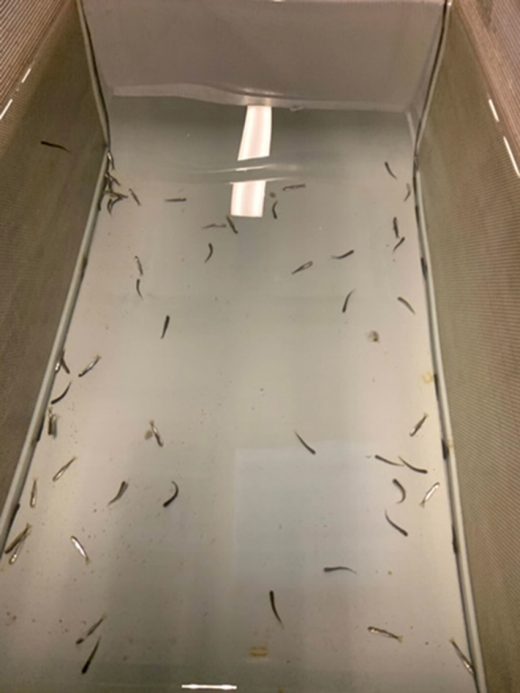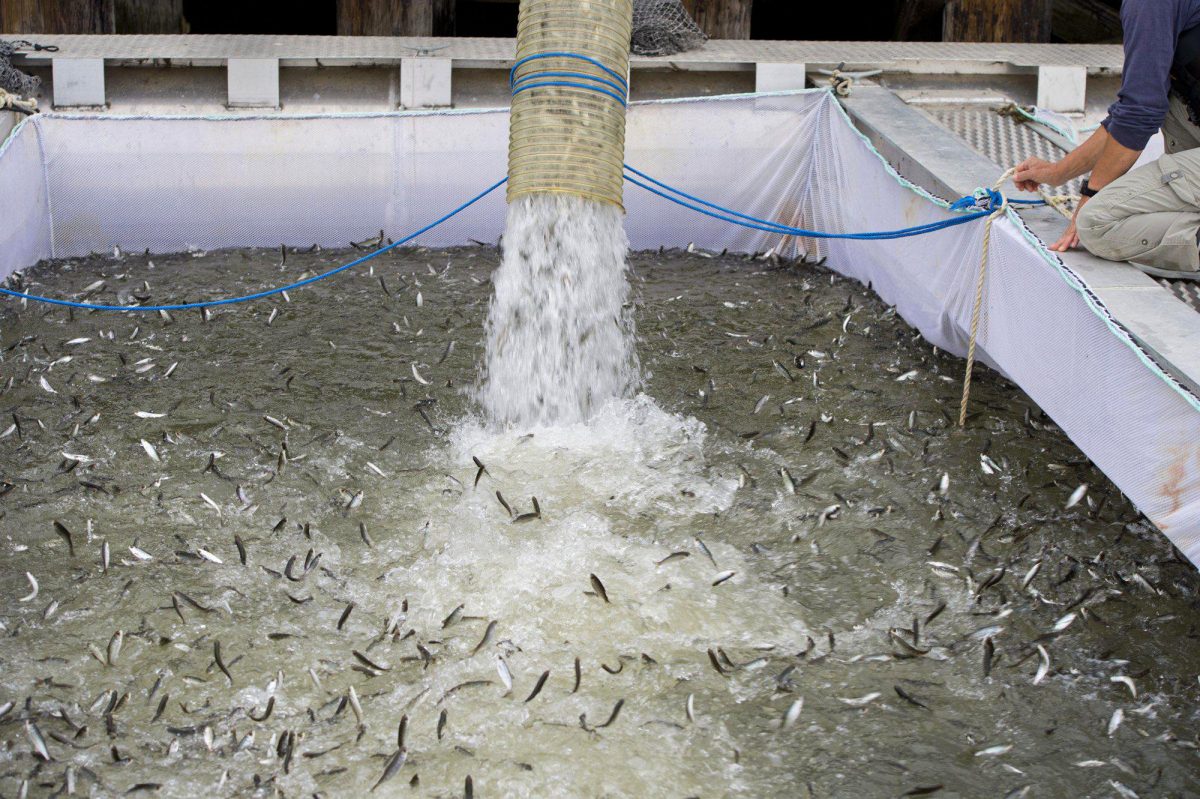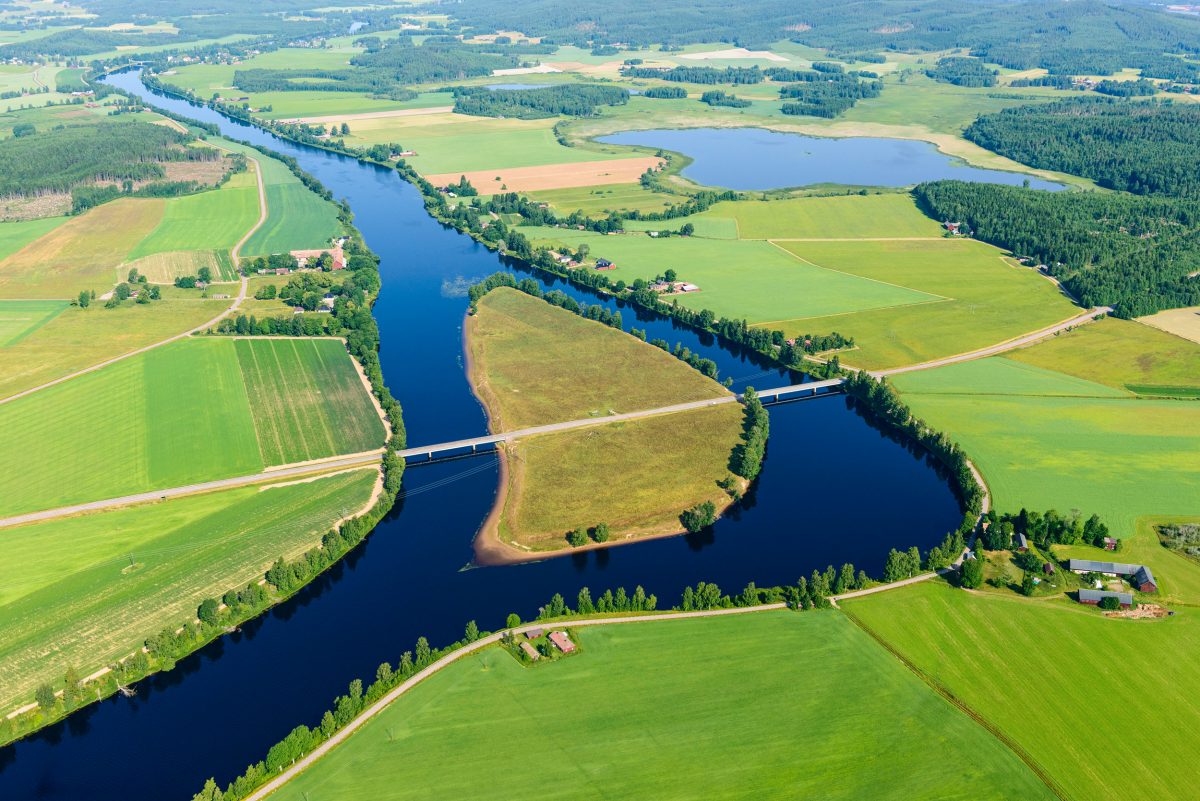The Ocean’s Mysterious Vitamin Deficiency
A puzzling lack of thiamine is disrupting some marine ecosystems.
Article body copy
Disoriented little fish caught the attention of staff members at the Coleman National Fish Hatchery in Red Bluff, California, in early January 2020. Looking down into the outdoor tanks, called raceways, the facility’s employees noticed that among the dark, olive-colored clouds of live fish, there were occasional slivers of silver from the undersides of tiny fry that were struggling to swim. The fish would roll onto their sides, sink to the bottom for a moment, spring back upright, swim a few strokes, and then roll over again.
Many were dying, too. While a few hundred mortalities daily in a facility containing millions of fish is normal, something was definitely amiss.
“[Mortality] was in the thousands, and it didn’t go down,” says Brett Galyean, project leader at the hatchery.
Galyean and his team had already hatched and released into the raceways between six and seven million fish—about half of Coleman’s annual production—and the prospect of losing many or most of them began to seem very real.

Hatchery workers at the Coleman National Fish Hatchery in Red Bluff, California, were first alerted to a problem in their raceways when they saw salmon fry swimming erratically and lying on their sides, as shown here. Photo courtesy of Brett Galyean/FWS
Biologists at the California-Nevada Fish Health Center, an on-site lab at the hatchery, which is located on a tributary of the Sacramento River, inspected the fish but couldn’t make a diagnosis. A few samples were sent to the nearby University of California, Davis, for more testing.
Around that time, Galyean recalls, other salmon hatcheries in the state began reporting unusually high mortality rates in their fish. Whatever was afflicting Coleman’s salmon was evidently impacting fish across Northern California. Short of better explanations, Galyean and his colleagues grew concerned that a virus was sweeping through their brood.
Grasping for ideas as thousands of fish expired daily, they turned to the internet, where they dug up published research on nutritional deficiencies in trout from the Great Lakes as well as Atlantic salmon on the East Coast. Several decades ago, sick and dying fish in these regions had been found to be deficient in thiamine (also spelled thiamin), or vitamin B1, a basic building block of life critical to the functioning of cells and in converting food into energy.
Encouraged by the finding, the Fish Health Center’s biologists ran a trial, submerging about half of the fry in a bath of water and dissolved thiamine powder, and it worked like a charm, Galyean says. After several hours, nearly all the treated fish were behaving normally while symptoms continued in an untreated control group.
Coleman, as well as the other hatcheries, scaled up the treatment and applied it to more than a million fry. It did the job in the short term, but it didn’t solve the underlying problem. Since the fish acquire thiamine by ingesting it through their food, and females pass nutrients to their eggs, the troubling condition indicated that something was amiss in the Pacific Ocean, the last place the fish eat before entering fresh water to spawn.

The Coleman National Fish Hatchery was able to temporarily reverse the problem with its fish by bathing and injecting them with thiamine, but since thiamine is synthesized in the environment and passes through the food chain, there are concerns that something amiss in the marine environment is ultimately disrupting the production and transmission of this critical vitamin. Photo by Randy Pench/Sacramento Bee/Alamy Stock Photo
California researchers now investigating the source of the salmon’s nutritional problems find themselves contributing to an international effort to understand thiamine deficiency, a disorder that seems to be on the rise in marine ecosystems across much of the planet. It’s causing illness and death in birds, fish, invertebrates, and possibly mammals, leading scientists from Seattle to Scandinavia to suspect some unexplained process is compromising the foundation of the Earth’s food web by depleting ecosystems of this critical nutrient.
Thiamine originates in the lowest levels of the food web, where particular species of bacteria, phytoplankton, fungi, and plants synthesize the compound de novo—meaning from anew—by assembling and linking existing compounds into vitamin B1, which naturally occurs in multiple forms. Thiamine then passes through the food chain and eventually finds its way into every animal and plant on Earth. No organism can live without it. In animals, thiamine interacts with several enzymes and helps generate energy within cells, making possible the most basic of metabolic processes. Without enough thiamine, cellular-level functioning begins to fail. Affected animals behave abnormally, suffer neurological and reproductive disorders, and can eventually die.
Scientists have understood thiamine deficiency as a serious health risk in some human populations for nearly a century, but it wasn’t until the 1990s that a Canadian scientist named John Fitzsimons helped pinpoint the disorder as a threat to wildlife. He was working in Ontario with Fisheries and Oceans Canada at the time and trying to understand why Great Lakes trout populations continued to decline, even after industrial pollution had decreased substantially and water quality improved. Studying lake trout born in captivity, Fitzsimons observed symptoms like hyperexcitability, loss of equilibrium, and other abnormal behavior. He wondered if a nutritional deficiency was at play, and to test for this he dissolved various vitamin tablets in water and—using trout in different life stages, including fertilized eggs—administered the solutions to the fish, both through injection and baths. The idea was to see which vitamin, if any, cured the condition.
“It came down to a range of B vitamins, and it was only the thiamine that was able to reverse the signs I was seeing,” he says.
Fitzsimons’s research, which he published in 1995, guided other scientists, in the Great Lakes region as well as northern Europe, who have since identified thiamine deficiency in dozens of species in the northern hemisphere. In 1998, for example, environmental biochemist Lennart Balk and colleague Gun Åkerman of Sweden’s Stockholm University published findings that thiamine deficiency was responsible for high mortality rates in juvenile Atlantic salmon in the Swedish river Dalälven. Several years later, they linked thiamine to a peculiar paralytic condition affecting birds of more than two dozen species in the Baltic Sea region. In a paper published in 2009, they noted that the condition apparently caused female birds to lay fewer eggs and fewer hatched chicks to survive. The authors proposed that breeding failure related to thiamine deficiency might be responsible for widespread bird population declines.

Thiamine deficiency has been identified in terrestrial, freshwater, and marine ecosystems in various parts of the world, including the Swedish river Dalälven, where researchers linked the deficiency to the high mortality rate of the river’s juvenile Atlantic salmon. Photo by Utterström Photography/Alamy Stock Photo
Within a few years, Balk and his team of international collaborators had found thiamine deficiency affecting Baltic Sea blue mussels and eels captured along the North American east coast. By then, scientists were paying more attention to a particularly insidious threat of thiamine deficiency: its sublethal impacts, which, short of killing an individual, can severely affect stamina, strength, coordination, and memory, among other functions. In birds, along with reproductive failures, the condition may cause paralysis and a loss of the ability to vocalize. Ultimately, sublethal effects are about as bad as, if not worse than, lethal ones because they can harm creatures, and alter their behavior, over long periods of time without scientists even realizing it. This phenomenon, which Balk and his colleagues have written about, could have major implications for wildlife research efforts going back several decades.
Thiamine deficiency might not be limited to the water either. Balk says he has tested liver, brain, and blood samples from moose in southern Sweden and measured the levels of enzymes that correlate to thiamine activity. His results, he says, point toward “severe” thiamine deficiency.
In a 2016 paper, Balk and 20 coauthors sounded the alarm with a hypothesis that thiamine deficiency might be driving long-term wildlife population declines. Their paper noted that “population sizes of both terrestrial and marine vertebrate species dropped by half” from 1970 to 2012, “and from 1950 to 2010, the global seabird population declined overall” by 70 percent. These downslides, the authors explained, are happening faster than what would be expected of “known threats to biodiversity,” such as habitat loss.
By then, Balk and other scientists had clearly identified inadequate thiamine levels in species around much of the globe, but a root cause of the deficiency remained evasive.
“We’ve thought, It must be something in the air, or something in the water,” says Tracy Collier, an environmental toxicologist based in Seattle, Washington, who has collaborated with Balk on thiamine deficiency research.
Balk is equally mystified, but is confident that humans are to blame. The symptoms he has observed in thiamine deficient animals are so severe, he explains, that if natural phenomena were the cause, affected animal populations would have vanished or adapted long ago. Balk believes human activity is somehow sapping ecosystems of vitamin B1, either by blocking production or obstructing its passage from one trophic level to the next.
So does Dale Honeyfield, who worked with the US Geological Survey as a research chemist and has studied thiamine deficiency since the mid-1990s.
“Humans are somehow involved,” he says. “Thiamine deficiency is really an indicator that we have an ecosystem that is disrupted.”
Scientists are floating various explanations for what’s depriving organisms of this nutrient, and some believe that changing environmental conditions, especially in the ocean, may be stifling thiamine production or its transfer between producers and the animals that eat them. Sergio Sañudo-Wilhelmy, a University of Southern California biogeochemist, says warming ocean water could be affecting the populations of microorganisms that produce thiamine and other vitamins, potentially upsetting basic chemical balances that marine ecosystems depend on.
“In different temperatures, different phytoplankton and bacteria grow faster,” he says.
This, he explains, could hypothetically allow microorganisms that do not produce thiamine—but, instead, acquire it through their diet—to outcompete the thiamine producers, effectively reducing thiamine concentrations in the food web.
Such a mechanism could be why Sañudo-Wilhelmy and several other researchers, during a research project about a decade ago, found low levels of B vitamins, including thiamine, in water samples collected off the coast of Baja California.
Even if microorganisms produce thiamine in abundance, the vitamin must travel up the food web, and various hypotheses from recent studies explain how this transfer could be getting blocked. Overfishing, for one, could disrupt this process. A team of scientists led by Samuel Hylander, of Linnaeus University in Sweden, and Maciej Ejsmond, of Jagiellonian University in Poland, have proposed that depletion of predatory fishes, like cod, in the Baltic Sea could allow overpopulation of smaller fish species that graze on zooplankton, especially the larger species such as copepods. This, in turn, would allow very small phytoplankton, which produce thiamine, to dominate the water column. But large animals such as birds and salmon rarely eat phytoplankton directly. Rather, they acquire thiamine after it has traveled higher up the food chain. Because thiamine does not pass from prey to predator very efficiently, with much of it lost in transmission, very little thiamine may reach the top of the food web in disrupted ecosystems, according to Ejsmond and Hylander’s modeling.
Even though thiamine is a critical nutrient, there is a counterintuitive twist to this story: thiaminase, a naturally occurring enzyme that destroys thiamine. Thiaminase is present in certain species of fish, plants, and microorganisms, some of which appear to use the enzyme to their advantage. Certain plants and bacteria, for example, can employ thiaminase to process thiamine that has been damaged or degraded and is of no nutritional value to most other life forms. And in certain fish species, thiaminase is believed to support the immune system.
However, when larger animals eat prey containing thiaminase, the enzyme rapidly destroys thiamine and can lead to a nutritional deficiency in the predator.
In the early 20th century, a small and invasive herring species called the alewife spread through the Great Lakes ecosystem, displacing the lakes’ native forage species. Alewife contains high concentrations of thiaminase, and as it became a major food source for lake trout, and other native fishes, the larger fish developed chronic thiamine deficiency. Their natural reproductive success deteriorated, and the trout’s population cratered. The Great Lakes’ saga illustrates the outsized impact that one single nutrient can have on an entire ecosystem.

Alewife contains thiaminase, an enzyme naturally found in some species that destroys thiamine. Fish that prey on the alewife subsequently have their thiamine stores depleted, leading to a nutritional deficiency. Photo by Martin Konopacki/Alamy Stock Photo
“It’s very eye-opening that the lack of a simple vitamin can cause complete collapse of populations in vast areas,” says Donald Tillitt, an environmental toxicologist with the US Geological Survey who has studied thiamine deficiency in fish in the Great Lakes for more than 20 years.
In California, thiaminase has become a lead suspect in the case of the Sacramento River’s salmon. Due to recent changes in surface water temperature, the coastal array of forage species has shifted. Chinook in this region usually eat a diverse range of prey, including many small fish species, krill, and squid. Yet for months—possibly years—before the 2020 spawning season, the salmon subsisted almost exclusively on northern anchovy, a species rich in the thiamine-destroying enzyme.
But the role of thiaminase in the mystery has become a dividing point in the research community. Some scientists believe the enzyme is a primary, or at least partial, cause of thiamine losses in higher organisms while others suspect a more complicated story is playing out in which thiamine production across wide areas has been interrupted. In California, Rachel Johnson, a fisheries biologist with the National Oceanic and Atmospheric Administration, is now studying the region’s nutritionally beleaguered chinook salmon, trying to understand what has stripped them of the critical vitamin.
Johnson says it’s impossible for now to know if thiaminase is causing the deficiency or if it might be the result of impacts to thiamine production and transfer through the food web.
To Balk—who leans toward the explanation of disrupted thiamine synthesis—it seems implausible that thiamine deficiency simultaneously affecting dozens of species in different ecosystems would be the result of different causes. The phenomenon, he says, calls for “a working hypothesis that it should be the same mechanisms in a clear majority of these species.”
Honeyfield also has a working hypothesis that some broad environmental change has altered thiamine production at the base of the food web.
“If there’s no synthesis going on at the bottom, then there’s no source to feed up through to the top predators,” Honeyfield says. “Exactly how that is playing out is a big, big question.”
Balk believes an ecological emergency is developing. He says that, with thiamine deficiency thoroughly established as a widespread problem, it is time to try to identify “the causative agents and the mechanism behind this.”
The wider research community, though, is paying attention. In 2018, a group of 24 experts conducted a type of overview called a “horizon scan” of more than 100 emerging issues that could potentially affect the planet’s wildlife and natural systems. They published a paper focusing on 15 of them, including changes in the global iron cycle and the use of lasers in deep-water trawl fishing. First on the list was the section “Thiamine Deficiency as a Possible Driver of Wildlife Population Declines.” Observing that thiamine deficiency doesn’t usually kill affected individuals but causes sublethal impacts such as behavioral and reproductive problems, the authors suggested that the nutritional deficit could be quietly chiseling away at wildlife populations across the northern hemisphere.
California’s chinook have been declining for decades despite conservation measures aimed at improving their freshwater habitat. Now, it seems that thiamine deficiency is worsening their plight. Adult fish began returning to the middle reaches of the Sacramento River and its tributaries to spawn last spring and summer, and at the hatcheries that collect and manually combine their eggs and sperm, the young fish again showed signs of a vitamin B1 shortage. Most of the hatcheries on the river have treated the problem by bathing the fry in thiamine solution, while the Coleman facility also injected the adult females with thiamine.
But these treatments don’t necessarily offer long-lasting results, and the health of the young salmon could deteriorate when they enter the marine environment where the deficiency seems to be originating.
“It’s like sending a kid with a fever off to school after giving them a Tylenol,” Johnson says.
Johnson is now leading a study involving analyzing the eye lenses of adult chinook.
“They are like little onion layers that archive what salmon eat over their lifetime,” she explains. The idea is to “reconstruct their diets and see whether we can link anchovies specifically to the low thiamine concentrations in eggs.”
That would all but pin the deficiency on thiaminase, the thiamine-destroying enzyme. However, a deeper-rooted cause could be at work, and only more research will tell if an environmental shift has flipped off the switch on thiamine production, or impeded its movement through the food web. More questions will certainly follow: how many species are being affected? Is the problem getting worse? And if humans caused the problem, can we reverse it?

